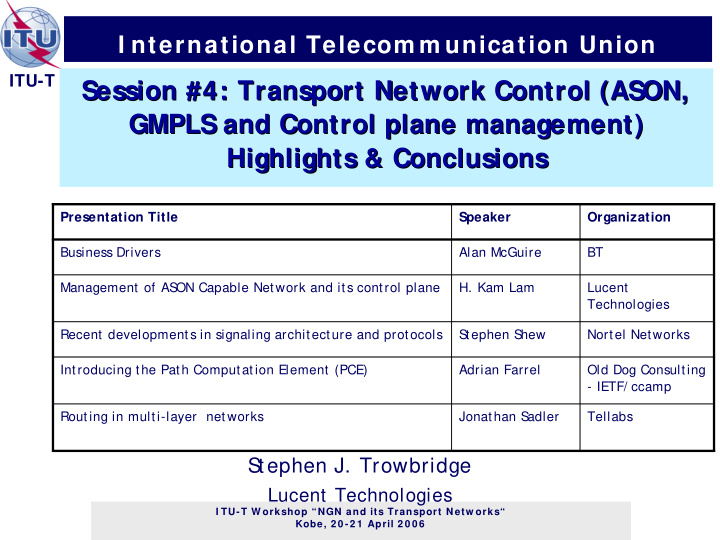



I nternational Telecom m unication Union ITU-T Session #4: Transport Network Control (ASON, Session #4: Transport Network Control (ASON, GMPLS and Control plane management) GMPLS and Control plane management) Highlights & Conclusions Highlights & Conclusions Presentation Title Speaker Organization Business Drivers Alan McGuire BT Management of AS ON Capable Network and its control plane H. Kam Lam Lucent Technologies Recent developments in signaling architecture and protocols S tephen S hew Nortel Networks Introducing the Path Computation Element (PCE) Adrian Farrel Old Dog Consulting - IETF/ ccamp Routing in multi-layer networks Jonathan Sadler Tellabs Stephen J. Trowbridge Lucent Technologies I TU-T W orkshop “NGN and its Transport Netw orks“ Kobe, 2 0 -2 1 April 2 0 0 6
Highlights from Presentation 1 “Business Drivers” ITU-T The starting point is Service Management o Radically Simplified Network - Mesh and Cross-Connect o based rather than Ring Based - more effective utilization OPEX reduct ion (eliminate manual steps) and CAPEX o reduction (more efficient utilization through shared restoration) Soft Permanent Connections are the primary driver today. o Not ready for high penetration of Dynamic Switched o S ervices (bandwidth on demand). From long holding times, Erlang theory indicates delay to set up service would be unacceptable when blocking occurs I TU-T W orkshop “NGN and its Transport Netw orks“ Kobe, 2 0 -2 1 April 2 0 0 6 2
Highlights from Presentation 2 “ Managem ent of ASON Capable Netw ork and its control plane ” ITU-T Management is Key to Control Plane deployment. o Management of Control Plane as well as transport plane. Encompasses Configuration Management, Fault o Management, Performance Management, Accounting Management, Security Management Framework and Requirements Recommendation approved. o Information model and solution set are in progress and expected to finish soon. The management plane will still be the “ captain” even o with introduction of the control plane. Progress on control plane management has benefited from o effective collaboration among S DOs (ITU-T, OIF, TMF, IETF). I TU-T W orkshop “NGN and its Transport Netw orks“ Kobe, 2 0 -2 1 April 2 0 0 6 3
Highlights from Presentation 3 “ Distributed Signalling and Multiple Transport Layers ” ITU-T o S ignaling architecture is composed of interrelated components developed by multiple standards organizations (IETF, OIF, ITU-T S G15). S DOs are cooperating to develop protocol pieces to support different architectures. o An extensive signalling interoperability demonstration was undertaken involving 7 carriers and 13 equipment vendors. o Recent signalling work is solving problems with inter-area (domain) signalling and multi-layer interworking (e.g., when a server layer connection must be established to support a client layer call) I TU-T W orkshop “NGN and its Transport Netw orks“ Kobe, 2 0 -2 1 April 2 0 0 6 4
Highlights from Presentation 4 “I ntroduction to the Path Com putation Elem ent” ITU-T Work is progressing rapidly to define essential protocol o building blocks. The Path Computation Element (remote path query) is one such building block under development to deal with limited TE visibility. Virtual Link and Virtual Node abstractions both have o drawbacks Can be employed in a variety of architectural models (co- o located with connection controller, separate server, incorporated into NMS, or cooperating PCE servers across different domains. Applicable t o ASON architecture - new Rec. G.7715.2 o requirements and architecture for remote path query. I TU-T W orkshop “NGN and its Transport Netw orks“ Kobe, 2 0 -2 1 April 2 0 0 6 5
Highlights from Presentation 5 “Routing in m ulti-layer transport netw orks” ITU-T Convergence drives us to networks comprised of multiple o technologies. Multi-Layer routing technologies being developed to support path computation in an environment made up of many different technologies in any layer that has switching flexibility. Need to represent server layer within client layer. Address o cases where client layer link is to be established over established or potential server layer trails. S erver layer can be represented as abstract node or topology shadow within client layer. Path Computation Element (PCE) can be employed as a o bridge in multi-technology networks, e.g., for nodes that do not support multi-layer control plane. I TU-T W orkshop “NGN and its Transport Netw orks“ Kobe, 2 0 -2 1 April 2 0 0 6 6
CONCLUSI ONS ITU-T o Cooperation between S DOs (ITU-T, IETF, OIF, TMF, etc.) continues to be an essential part of control plane standards evolution. o Primary application for carriers is soft permanent connection support for network simplification, OPEX/ CAPEX reduction. o Management is still the “ captain of the ship” o Current challenges being addressed in S ignaling and Routing arise from networks comprised of multiple technologies (from convergence) (e.g., multi-layer networks), mutiple areas and domains. I TU-T W orkshop “NGN and its Transport Netw orks“ Kobe, 2 0 -2 1 April 2 0 0 6 7
Recommend
More recommend